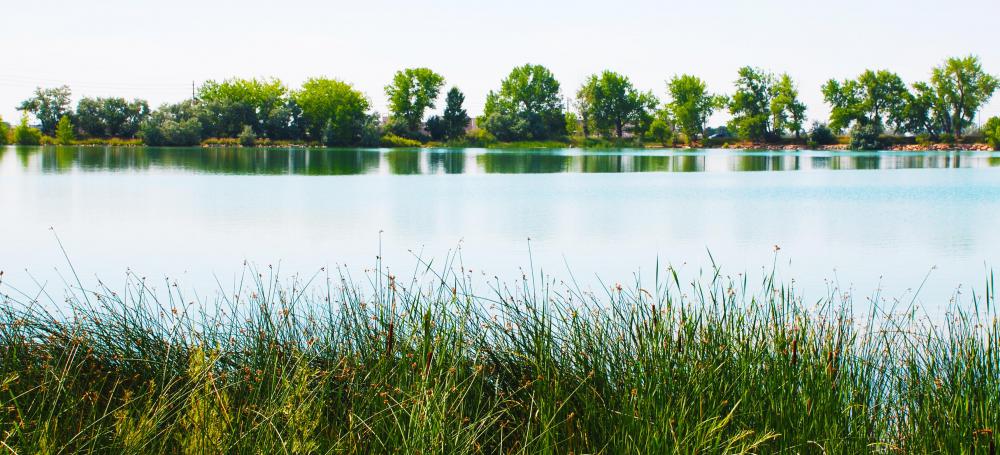At AllThingsNature, we're committed to delivering accurate, trustworthy information. Our expert-authored content is rigorously fact-checked and sourced from credible authorities. Discover how we uphold the highest standards in providing you with reliable knowledge.
What Is a Wetland Habitat?
A wetland habitat consists of an area covered by water at least part of the year, which provides an environment for wildlife and plant survival. Wetland habitats describe bogs, marshes, or swamps filled with freshwater, saltwater, or a combination of the two. Water quality and salinity determine the types of plants and animals that inhabit wetlands and the level of nutrients in the soil.
A marsh typically represents shallow areas on the borders of rivers, lakes, or coastal shores where grasses thrive. It may be a primarily saltwater or freshwater marsh, or a mixture of both. Water levels commonly change with the seasons and tidal action. A marsh wetland habitat usually contains reeds and wildflowers in soil with a low mineral content. Turtles, shrimp, and beavers are some examples of wildlife living in this type of wetland habitat.

Swamps refer to slow-moving rivers or streams where water levels are deeper than marshes. Plant species growing in swamps are woody, such as mangroves in salty wetlands and shrubs in freshwater wetland habitats. These areas typically consist of little drainage, with muddy floors. Various types of birds, otters, snakes, and alligators are common wildlife found in swampy wetland habitats.

Bogs and fens contain freshwater, with rainfall as the main source of moisture. Some bogs exist in low-lying areas where glacial lakes once covered the land. A fen contains high-alkaline soil and might be described as a peat wetland habitat with moss growing on the floor. Usually, few nutrients are found in a bog. Wildlife includes deer that feed on the plants, several species of birds, and a variety of insects.

A wetland habitat provides critical links in the food chain, from alligators to dragonflies. It also serves as a nesting spot for birds and a spawning region for certain species of fish, including trout and salmon. Migratory birds use a wetland to rest, while some small animals find protection from prey in this environment. A wetland habitat might provide a year-round home to otters, bobcats, and other wildlife.

These areas are important to the ecosystem because they reduce flooding by allowing excess water to collect when river levels run high. A wetland habitat also prevents soil erosion because plants hold the dirt and filter out sediment, improving water quality. Along with providing nutrients for fish and wildlife, wetlands serve as recreation areas for bird-watchers and anglers.

Efforts in some regions to restore or preserve wetlands began after these areas were filled or drained to create building sites, roads, farmland, or pastures. The value of a wetland habitat received international recognition as these areas were lost. In some areas, new wetland areas are created to replace destroyed habitats.
Frequently Asked Questions
What defines a wetland habitat?

A wetland habitat is an ecosystem characterized by water saturation at or near the surface of the soil for most of the year. This unique environment supports both aquatic and terrestrial species, with vegetation adapted to the hydric soil. Wetlands serve as crucial buffers in the landscape, filtering pollutants and providing wildlife habitat.
Why are wetlands important for biodiversity?

Wetlands are biodiversity hotspots, supporting an array of species not found elsewhere. They provide critical breeding, nesting, and feeding grounds for birds, fish, amphibians, and invertebrates. According to the Ramsar Convention, wetlands are vital for maintaining the global biological diversity of many species, including a third of all threatened species.
How do wetlands contribute to flood control?

Wetlands act as natural sponges, absorbing and storing excess rainfall and reducing flood peaks. By slowing down water flow, they mitigate the impact of flooding downstream. The U.S. Environmental Protection Agency states that one acre of wetland can store up to 1.5 million gallons of floodwater, showcasing their significance in flood control.
What are the different types of wetlands?
There are several types of wetlands, including marshes, swamps, bogs, and fens. Marshes are typically grassy areas flooded with water, while swamps are forested wetlands. Bogs are freshwater wetlands with spongy peat deposits, acidic waters, and a floor covered by a thick carpet of sphagnum moss. Fens are similar but are fed by groundwater and are less acidic.
How do wetlands filter pollutants from water?
Wetlands purify water by trapping sediments and absorbing nutrients and pollutants like nitrogen and phosphorus. The plants, bacteria, and soil in wetlands act together to break down contaminants, effectively removing them from the water cycle. This natural filtration process helps maintain the cleanliness and health of our waterways.
Are wetlands at risk, and what can be done to protect them?
Wetlands are indeed at risk due to urban development, agriculture, and climate change. Protection efforts include legal regulations, such as the Clean Water Act in the United States, which restricts wetland alteration. Conservation strategies also involve restoration projects and the creation of protected areas. Public education and community involvement are key to preserving these vital ecosystems.
AS FEATURED ON:
AS FEATURED ON:


















Discuss this Article
Post your comments